It’s a big day everyone! The day your intestinal microbiota have been begging you for. The day you say goodbye to expensive store bought kombucha. The day you become a brewmaster as I impart on you the secrets of homemade kombucha!
The goal of this guide is to be your one stop shop for homemade kombucha brewage, from SCOBY-less to fermented perfection. No hopping around the interwebs. No fuss. No confusion. Because making homemade kombucha is so simple (albeit a bit slow), and I hope after reading this you’ll give it a whirl! Let’s hop right to it.
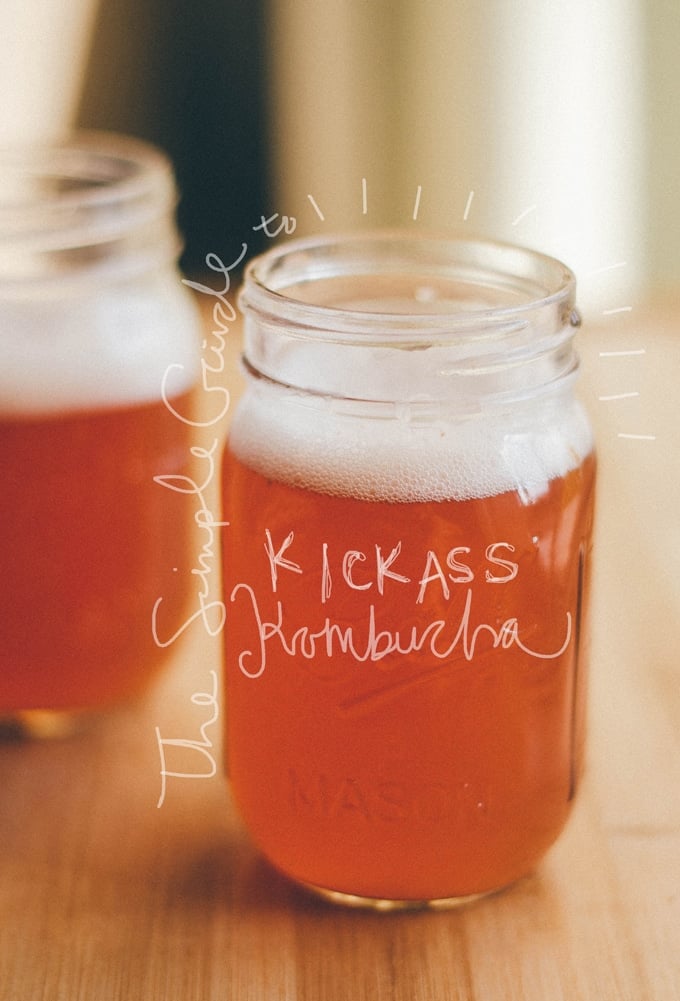
How to Make Homemade Kombucha: Overview
This post will go into detail about each step in the process of making kombucha. For succinct instructions, scroll to the bottom where a recipe card lays out the basics of making homemade kombucha. The general order of things goes something like this (you can jump around this tutorial by clicking the links below):
- Make SCOBY (1 to 4 weeks) – to make the “mother”
- First Fermentation (6 to 10 days) – to make the actual kombucha
- Second Fermentation (3 to 10 days) – to carbonate the kombucha
You can also click to jump to a few useful resources:
- Supplies needed – My top tools for brewing ‘buch
- Kombucha FAQ – Be sure to check out the comments section as well for answers to many questions
How to Make Kombucha Video
Before we start, here are some general notes that are consistent throughout the whole homemade kombucha process.
- No metal or plastic containers. Metal can react with the acidic kombucha and hurt your SCOBY, while plastic can house nasty bacteria that you don’t want sneaking in.
- Clean is key. A recurring theme in kombucha brewing is that EVERYTHING must be CLEAN! We’re creating the perfect environment for good bacterial growth, but if a bad bacteria slips in, it could ruin your batch (and make you pretty sick).
- Temperature plays a role. Fermentation goes a bit quicker in warmer temperatures, and a bit slower in colder.
- No mold zone. If you see any mold growing on your SCOBY or in the tea (which I understand can be difficult to discern from the hideous SCOBY, but will generally be green, white, or black), then toss your whole batch.
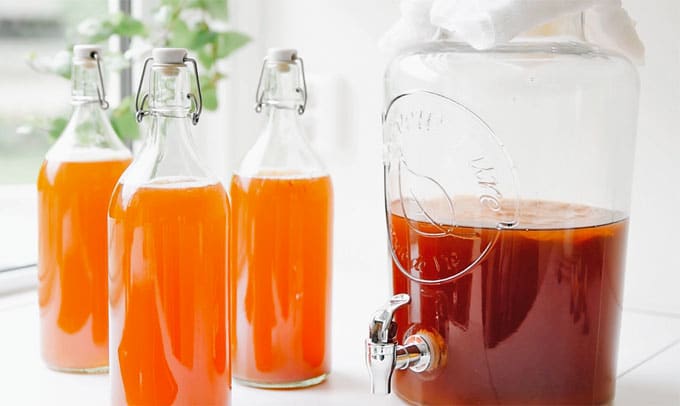

1. How to make a homemade kombucha SCOBY
The SCOBY (symbiotic culture of bacteria and yeast) is the mother of the kombucha, providing bacteria and yeast to ferment the sweet tea, protecting the tea from outside contaminants, and providing a loose seal to keep a bit of the carbonation in. Yes, it’s scary and alien looking and Buzzfeed did a whole article about how ugly this mama is…but it’s the very essence of kombucha! It brings the love and flavor and magic!

Making a SCOBY Ingredients:
- 7 cups (1.6 L) clean water
- ½ cup (100 g) white sugar
- 4 bags black tea (or 1 Tbsp loose tea)
- 1 cup (235 mL) unpasteurized, unflavored store bought kombucha
- A large glass or ceramic container (two jars holding at least ½ gallon (1.9 L) each, or one jug holding at least 1 gallon (3.7 L)). Alternatively, use a glass jug with a built in spigot to make pouring the kombucha out easier!
- Tightly woven cloth (coffee filters, paper towels, napkins, cheese cloth)
- Rubberbands
Making a SCOBY Instructions:
- Bring water to a boil in a clean pot. Remove from heat and dissolve sugar into it.
- Add the tea and allow to steep while water cools to room temperature (a few hours). Only when water is at room temperature is it ready to work with (test by drawing out some water with a paper straw, using your finger to keep the ‘buch in the straw).
- Pour the sweetened tea into your jar(s), then pour store-bought kombucha in (if you’re using two jars, pour ½ of the storebought kombucha into each), making sure to include any little gunkies that may be at the bottom. These are good!
- Cover with a few layers of the tightly woven cloth (keeps out bugs and debris) and secure with a rubber band.
- Set somewhere dark, still, and room temperature (70-75 degrees F, 21-24 C), like a cupboard, for 1 to 4 weeks, until a ¼ inch (½ cm) SCOBY has formed.
- Keep SCOBY in its original tea until you’re ready to brew your first batch. The SCOBY should live and grow for years if treated with love. The tea you used to make the SCOBY, however, is very vinegary and should be tossed. Don’t use this tea as the starter to your first fermentation!
Things to note when making your SCOBY:
- No decaf. The SCOBY doesn’t like decaf tea and will not grow as well if fed it (SCOBY = my spirit animal)
- Only black tea. Similarly, the SCOBY doesn’t grow as well with green or fruity teas. By all means, once your SCOBY is big and strong you can use green tea, but for now stick with black.
- No honey. Honey can contain botulism bacteria that, when grown exponentially as bacteria and yeast tend to do in kombucha, can be dangerous. You can use honey in the second fermentation, once there are a higher number of good bacteria to fight off the bad, but for now, stick to sugar.
- Don’t mess with it! You won’t see anything but a few bubbles in the first few days. But then one day a thin, translucent layer will form, eventually thickening into a full on SCOBY. If it floats sideways or sinks, leave it! It’s just doing it’s SCOBY thang.
- It’s all in the proportions. As I mentioned, I made two SCOBYs with this recipe, and you could probably make more. As long as you keep the proportions in check (7 c water : 1 c starter : 4 bags tea : 1/2 c sugar), you’ll be fine. Also note that this is the same proportion we’ll use in the first fermentation, but on a larger scale to make more ‘buch!
- Got leftovers? Never throw your SCOBY away! Share the kombucha love by gifting it to a friend, or make it into a delicious gummy candy!
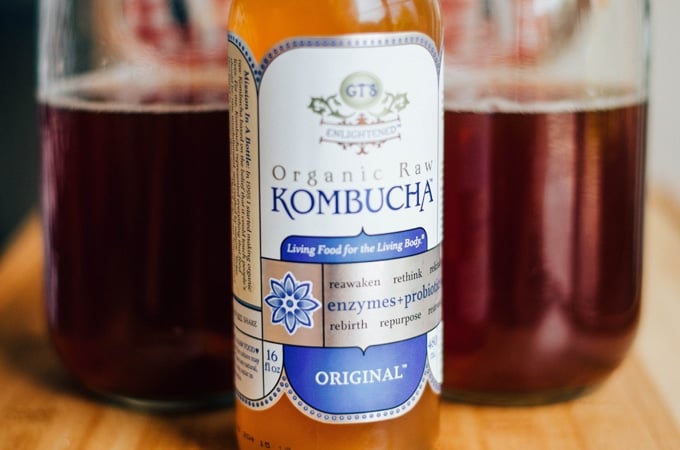
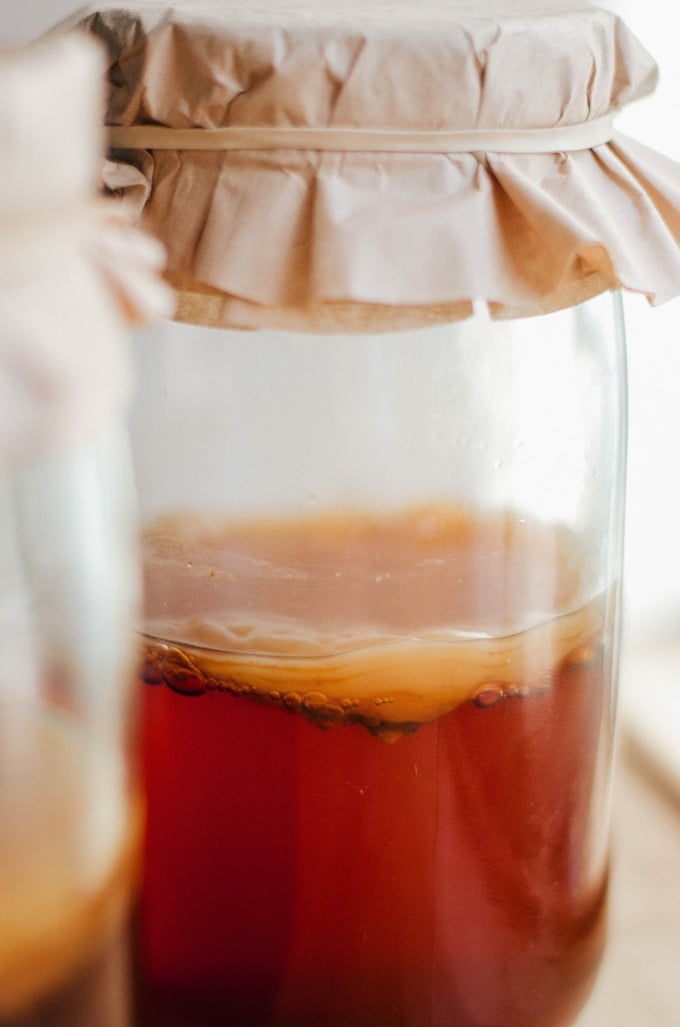

2. Homemade kombucha: The first fermentation
So you’ve got a newbie SCOBY and you’re ready to get this komboo-choo train rollin’. This first fermentation is where you actually make the kombucha.
First Fermentation Ingredients:
- 14 cups (3.5 quarts, 3.3 L) clean water
- 1 cup (200 g) white sugar
- 8 bags black or green tea (or 2 Tbsp loose leaf)
- 2 cups (470 mL) unflavored kombucha (either from a previous batch or unpasteurized, unflavored store bought kombucha
- 1 or 2 SCOBYs (depending on how many containers you’re using, 1 per container)
- A large glass or ceramic container (two jars holding at least ½ gallon (1.9 L) each, or one jug holding at least 1 gallon (3.7 L)). Alternatively, use a glass jug with a built in spigot to make pouring the kombucha out easier!
- Tightly woven cloth (coffee filters, paper towels, napkins, cheese cloth)
- Rubberbands
First Fermentation Instructions:
- Bring water to a boil in a clean pot. Remove from heat and dissolve sugar into it.
- Add the tea and allow to steep while water cools to room temperature (a few hours). Again, MUST be room temperature. Don’t risk killing your SCOBY in hot water.
- With hands AS CLEAN AS A SURGEON’S (really clean), gently remove your SCOBY from the tea and place on an equally as clean plate. You can rinse out the jar if you want (without soap), but it’s not necessary.
- Pour the sweetened tea into your jar(s), then pour in unflavored starter kombucha (if you’re using two jars, pour ½ of the starter kombucha into each).
- Gently place SCOBY into jar then cover with a few layers of the tightly woven cloth and secure with a rubber band.
- Set the jar(s) somewhere dark, still, and room temperature (70-75 degrees F, 21-24 C) for anywhere from 6 to 10 days. Begin tasting the tea at about 6 days by gently drawing out some of the tea with a paper straw (using your finger to hold the tea in the straw, don’t use your mouth). It should be mildly sweet and slightly vinegary. The warmer the air temperature, the faster the kombucha will ferment. The longer the tea ferments, the more sugar molecules will be eaten up, the less sweet it will be.
- Reserve 2 cups from this batch to use as starter kombucha for your next batch (just leave it in the jar with SCOBY(s)). The rest can move into the second and final fermentation.
Things to note about the first fermentation:
- In this step, unlike in the making of the SCOBY, you can use other teas besides black. Feel free to experiment with green, white, oolong, or combinations of them. Fruit teas should be mixed with a few black tea bags to ensure the SCOBY mama gets what she needs to thrive.
- Once the SCOBY gets to be about an inch (2.5 cm) thick, peel off a few layers to create a second SCOBY (you can share the love and gift this to a friend!)
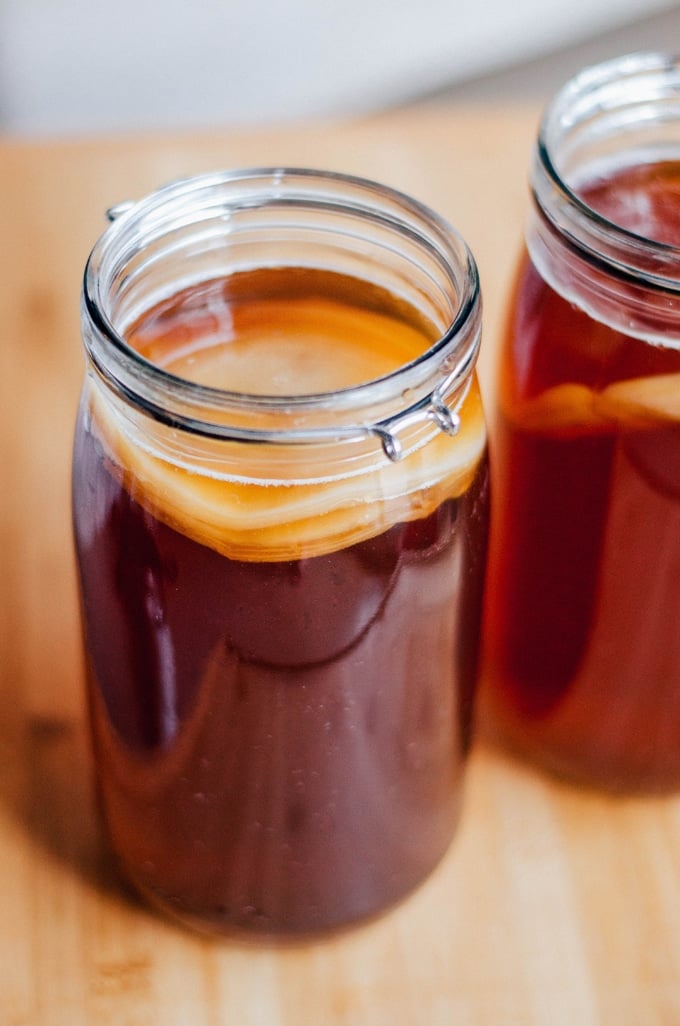

3. Homemade kombucha: The second fermentation
The final step and negotiably the best part of the process! The second fermentation is where the real magic happens. It’s where you can play around with sweet, fruity flavors that will not only make your homemade kombucha taste better than store-bought, but will give those good bacteria the power to kick it into high carbonation gear, bringing everything together into effervescent bliss. Let’s finish this.
Second Fermentation Ingredients:
- Homemade kombucha from the first fermentation
- Sweetener (fruit, honey, or sugar). Here are a few ideas per 1 cup kombucha:
- 1 to 2 Tbsp mashed fruit or fruit juice
- A slice of orange
- 1 to 2 tsp honey
- a piece of peppermint candy
- a piece of candied ginger
- *to add chia seeds, see below under “things to note”
- A few flip top fermentation bottles (bottles meant for fermentation have an airtight seal, which will prevent carbonation from escaping. If you don’t have these, canning jars will do an alright job, though they aren’t truly airtight.)
Second Fermentation Instructions:
- Strain kombucha and funnel into bottles, leaving about 1 1/2 inches at the top (3.8 cm).
- Add your chosen sweetener and seal tightly with lid.
- Let ferment somewhere dark and room temperature for 3 to 10 days.
- If desired, strain out fruit before serving. Place in fridge to slow the carbonation process.
Things to note about the second fermentation:
- Your jars can explode if the pressure becomes too high! For your first few batches while you’re still getting the hang of how kombucha reacts to your environment, bottle a portion of it in a plastic bottle. This will act as a gauge for how the others are doing. When the plastic bottle is rock solid, the rest are probably done. “Burp” them by opening each to release some pressure, then place them in the refrigerator to slow fermentation.
- Carefully open bottles over the sink with a towel in hand.
- The more sugar/fruit you add, the faster the kombucha will ferment and become carbonated.
- Chia seeds are my favorite addition to kombucha. Rather than adding these to the ‘buch when we add the sweetener, we’ll stir these in at the very end after the kombucha has been carbonated. Use 1 Tbsp of chia seeds per 1 cup of kombucha. Stir in the seeds and allow them to do their absorbing thang for a few hours, stirring every once in a while to keep them from clumping.
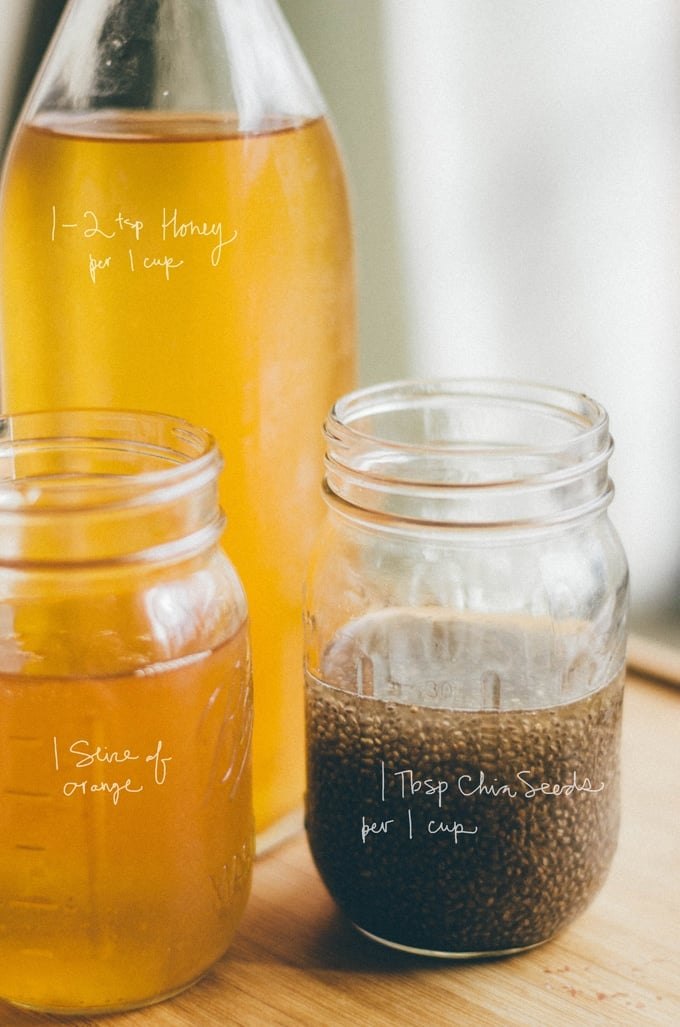
Favorite Kombucha Flavors
I’m always experimenting with new flavors of kombucha. I’m always adding new kombucha flavors to this list, but here are a few of my favorites:
- Mango Kombucha
- Blueberry Kombucha
- Ginger Pepper Kombucha
- Pineapple Basil Kombucha
- Strawberry Kombucha (perfect for a Kombucha Ice Cream Float)
- Peach Pie Kombucha
- Mojito Kombucha
- Lemon Ginger Kombucha (great in a Kombucha Radler)
- Apple Cinnamon Kombucha
- Pumpkin Spice Kombucha
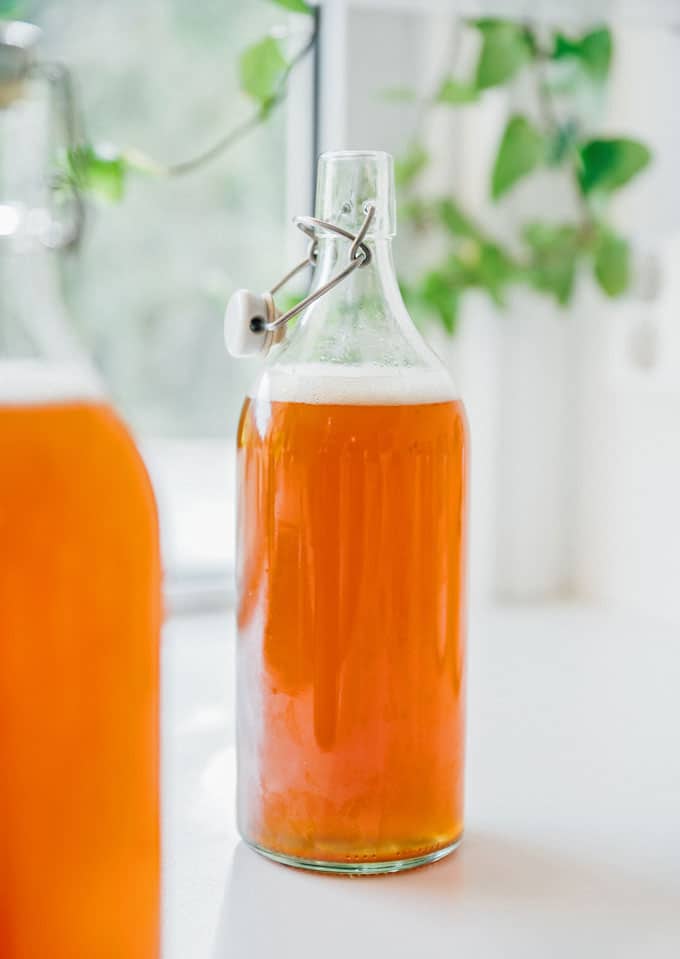
Supplies Needed for Making Kombucha
Below is a list of the supplies needed to make kombucha. The links are affiliate links, meaning I may earn a commission if you make a purchase (I’ve only included products I know and trust).
- Black tea: Plain black tea lays the base for your kombucha.
- Store bought starter tea: You’ll need a starter tea to get things going (but can use your home brewed kombucha to start the following batches).
- Large glass or ceramic container: Aim for one that’s at least 1 gallon, but two 1/2 gallon jars will also work! I’ve also been using a large jar with a plastic spigot recently, and it makes pouring the kombucha so much easier.
- Cheese cloth: Allows your kombucha to breathe while keeping dust and critters out.
- Flip top fermentation bottles: These bottles have a tight seal specifically designed to keep the carbonation in (hellooo fizz!)
- Starter kit: Want kombucha sooner than later? This bundle includes most of the equipment you need plus it comes with a ready-made SCOBY.
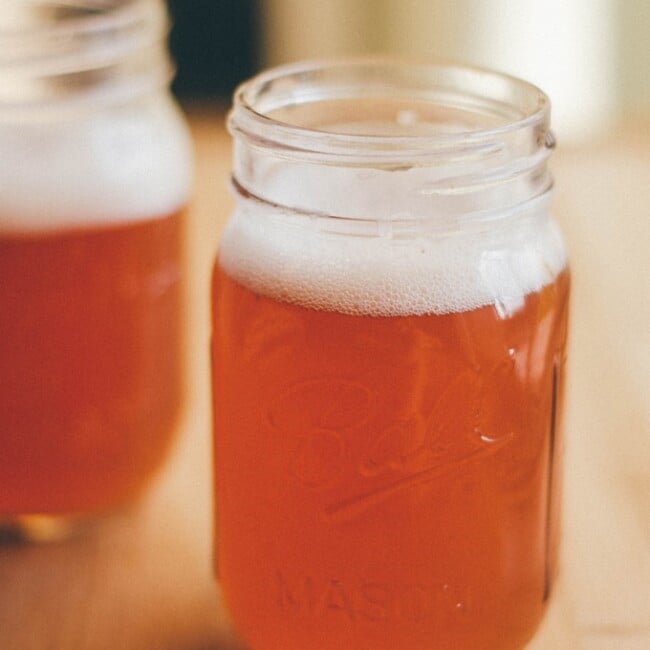
Ingredients
Making a SCOBY
- 7 cups clean water 1.6 L
- ½ cup white sugar 100 g
- 4 bags black tea or 1 Tbsp loose tea
- 1 cup unpasteurized, unflavored store-bought kombucha 235 mL
First Fermentation
- 14 cups clean water 3.5 quarts, 3.3 L
- 1 cup white sugar 200 g
- 8 bags black or green tea or 2 Tbsp loose leaf
- 2 cups unflavored kombucha (from previous batch or store-bought kombucha) 470 mL
- 1 or 2 SCOBYs 1 per container
Second Fermentation
- Homemade kombucha from the first fermentation
- Sweetener
Instructions
Making a SCOBY
- Make Tea: Bring water to a boil in a clean pot. Remove from heat and dissolve sugar into it. Add the tea and allow to steep while water cools to room temperature. Only when water is at room temperature (test by drawing out some water with a straw), is it ready to work with!
- Add Starter: Pour the sweetened tea into your jar(s), then pour store-bought kombucha in (if you’re using two jars, pour ½ of the store bought kombucha into each).
- Ferment: Cover with a few layers of the tightly woven cloth and secure with a rubber band. Set somewhere dark and room temperature (70-75 degrees F, 21-24 C) for 1 to 4 weeks, until a ¼ inch (½ cm) SCOBY has formed.
First Fermentation
- Make Tea: Bring water to a boil in a clean pot. Remove from heat and dissolve sugar into it. Add the tea and allow to steep while water cools to room temperature.
- Add Starter: With really clean hands, gently remove your SCOBY from the tea and place on a clean plate. Rinse out jar(s). Pour the sweetened tea into your jar(s), then pour in starter kombucha.
- Ferment: Gently place SCOBY into jar then cover with a few layers of the tightly woven cloth and secure with a rubber band. Set the jar(s) somewhere dark and room temperature (70-75 degrees F, 21-24 C) for anywhere from 6 to 10 days. Begin tasting the tea at about 6 days by gently drawing out some of the tea with a straw. The longer the tea ferments, the more sugar molecules will be eaten up, the less sweet it will be.
- And Repeat: Reserve 2 cups from this batch to use as starter kombucha for your next batch (just leave it in the jar with the SCOBY(s)). The rest can move into the second fermentation.
Second Fermentation
- Flavor: Strain kombucha and funnel into bottles, leaving about 1 1/2 inches at the top (3.8 cm). Add your chosen sweetener and seal tightly with lid.
- Ferment: Let ferment somewhere dark and room temperature for 3 to 10 days.
- Serve: If desired, strain out fruit before serving. Place in fridge to slow the carbonation process.
Nutrition Information
Homemade Kombucha FAQs
Most kombucha contains less than 0.5% ABV (for reference, beer has about 5% ABV), so it is not likely that you will get drunk from kombucha.
The high amount of probiotics in kombucha mean that drinking too much can lead to GI discomfort (bloating and in some cases diarrhea). Kombucha also contains caffeine and sugar, which may also effect you.
Kombucha contains probiotics, which contribute to a healthy gut microbiome (and in turn, help regulate weight and obesity). It also contains antioxidants and polyphenols.
When you put kombucha in the refrigerator, fermentation slows down dramatically. You can therefore store it in the fridge if you need to take a break from fermenting, or to chill it prior to serving.
This is one of few recipes where you really cannot use sugar substitutes. BUT you won’t actually be consuming that whole 1 cup of sugar. The sugar is food for the bacteria and yeast. They’ll basically eat it all up and produce wonderful things like acidity and carbonation, and the finished kombucha will be much lower in sugar as a result.
Yes! Your kombucha SCOBY may sink or float around the container. This is totally normal and nothing to worry about. It will likely float back to the top eventually, or a second SCOBY may form on top (which is also okay).
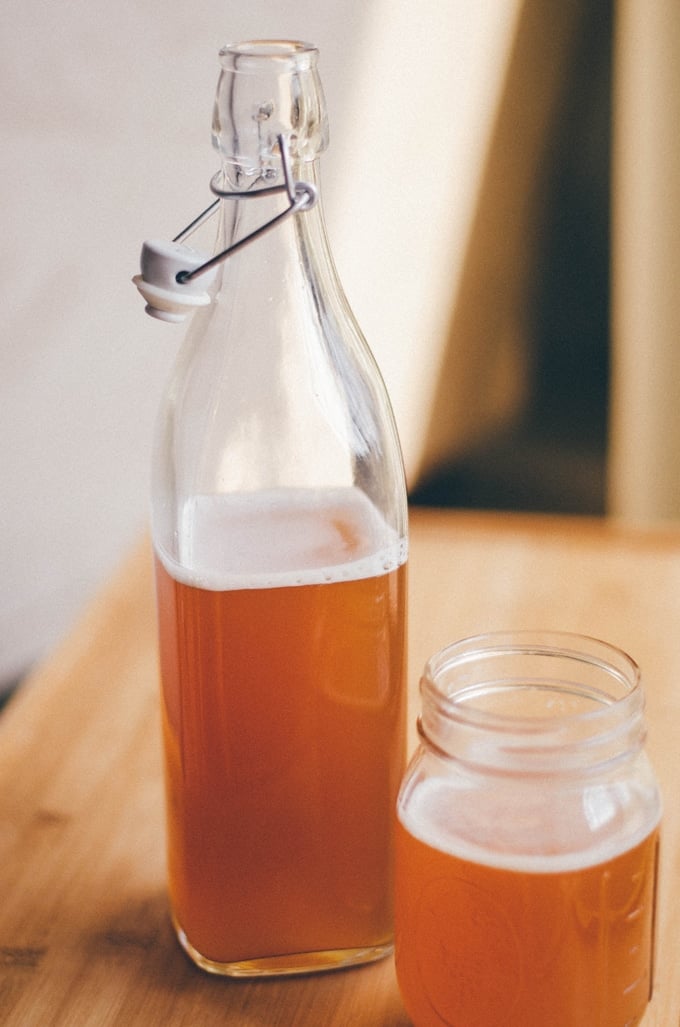
Homemade Kombucha: Bringing it all together
I drew this way professional depiction of the whole process for the visual learners. If you have any questions or hesitations about brewing homemade kombucha, don’t hesitate to comment below and I’ll help ya out! Happy brewing!
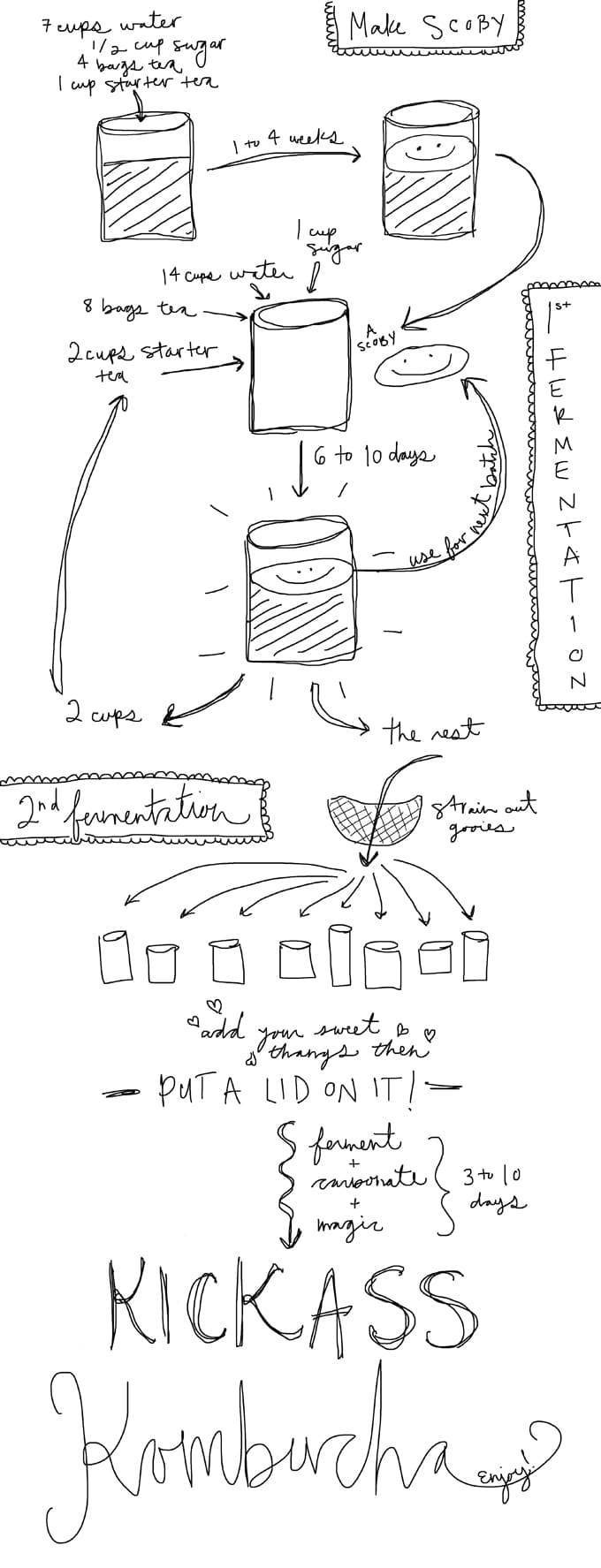
Print the Homemade Kombucha Guide
By popular demand, I’ve created a printable PDF with all the instructions from this post. Enter your email below and it will be sent to you!

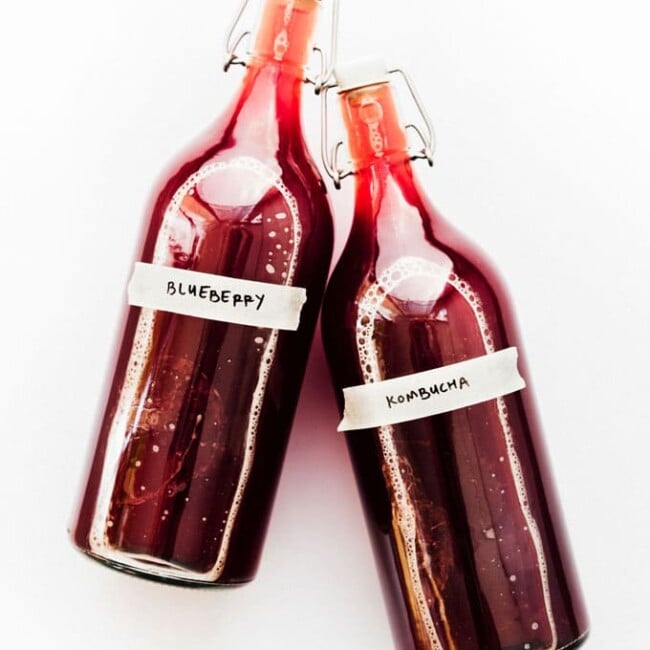
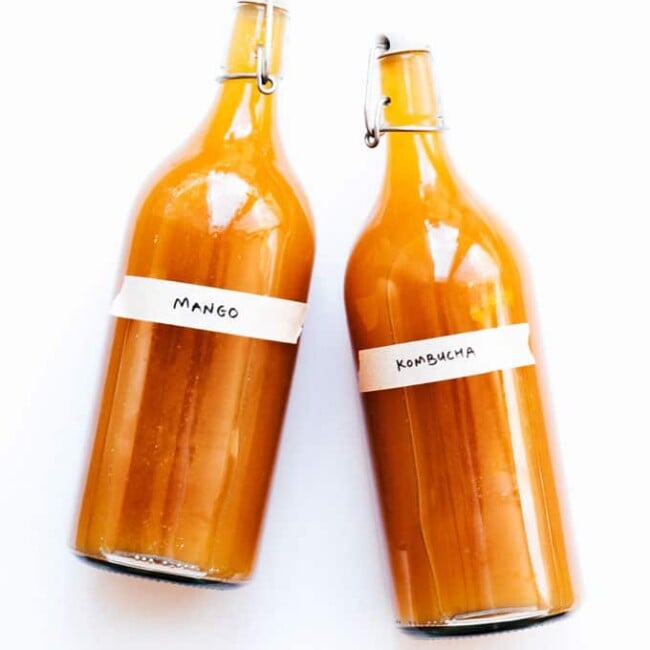
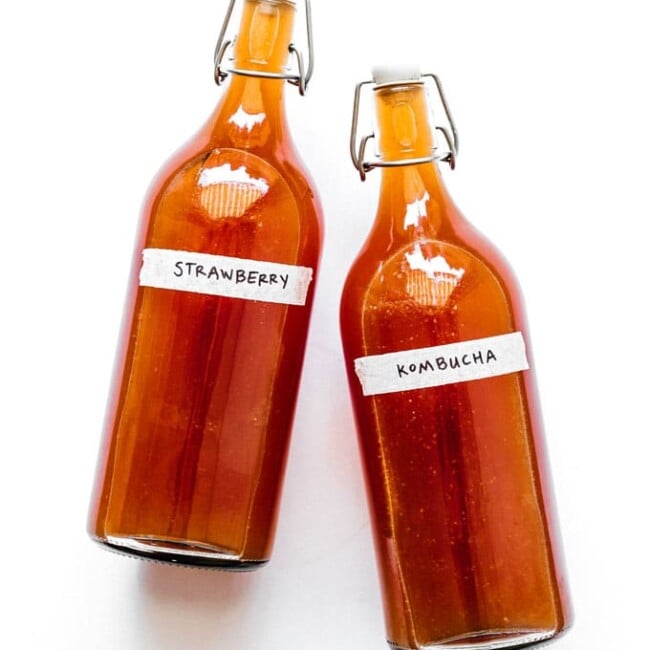
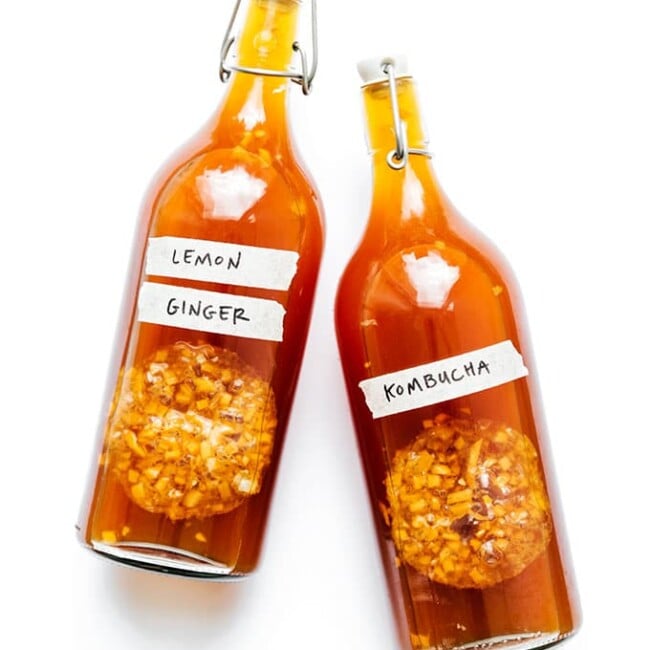
LEE says
I’ve heard I can make Kombucha without the starter kombucha. I have a scoby from a friend, but can’t find plain kombucha. I’m excited to get started! Any suggestions? Thanks!
Sarah Bond says
Did the SCOBY come with any liquid? That could be enough starter. You could also ask your friend for some kombucha from their batch! The starter is pretty important in kickstarting the reaction and preventing mold by making the environment acidic.
beth says
M
I am brewing a some kombucha , day 6 but it isnt forming another scoby. Any ideas as to why?
Sarah Bond says
It could be that it’s too cold and it’s fermenting slowly? Or perhaps not enough starter?
Gary MacKenzie says
I would like to make SCOBY using organic coconut palm sugar, and would like to know if you have any suggestions on how to deal with the sour or bitter flavor?
Sarah Bond says
Here’s our list of sugars that are best for brewing kombucha! 😀
Jaime says
Hi Sarah
First let me say thank you so much for your instructions on making homemade kombucha. I’ve been very excited about the process. My question is, should my scoby have thinner and thicker spots in it? I’m not sure if I have a scoby or not. It grew very slowly and I wasn’t sure that it was doing the right things so I started a second scoby. The second looks the same but grew much quicker.
Thank you for your help.
Jaime
Sarah Bond says
Yep that’s totally normal!
Sophia says
Love this process. Can I the scoby hotel go in fridge? I line in tropics?
Sarah Bond says
Putting it in the fridge increases your likelihood of mold because it effectively stops the fermentation. More on SCOBY hotels here!
Yvonne Norris says
Can you make kombucha without a SCOBY? And why did you discard the kombucha after you made the scoby? Was it bad???
Sarah Bond says
You can make kombucha without a SCOBY, but the fermentation will take longer (our guide to that here). And you can actually use that kombucha, I’ve changed that recommendation since publishing this – thanks for pointing that out!
tammy says
Yikes…… I put my kombucha together on Sunday and totally forgot to add in the sugar to my tea. Tomorrow is Wednesday….. is it too late to add sugar so now this is a lost batch and lesson learned…..??
Sarah Bond says
I think you could still add it! Dissolve it in a little black tea before adding it in.
Celia Lambert says
Hi Sarah, I love your Kombucha instructions. I clicked on your recommendation for a dispenser with a spigot on Amazon. That particular one is unavailable with no availability date. Do you have another recommendation? I’ve learned so much from your page, and would like for you to get the commission.
Sarah Bond says
Thanks so much for letting me know, Celia! This one appears to be the next best option 😀
Mel says
Thank you so much for all this info! Following your directions I successfully created a scoby and some wonderful kombucha and now a few months on I have multiple scobies and tonnes of delicious kombucha! So happy!!
Cathy says
Thank you for the information and recipe. I am excited to get started, however, I cannot find unflavored, unpasteurized kombucha. Y9ur amazon link says “unavailable” and does not know when or if it ever will be…..suggestions?
Matt Stricker says
Wonderful article!
I apologize if this has been asked already, but it mentions “Don’t use this tea as the starter to your first fermentation!”. However the brewbuch website seems to imply it’s okay: “reserve 2 cups of the liquid the SCOBY was growing in (that can be your starter kombucha)”
https://brewbuch.com/how-to-make-kombucha/
Any extra insight on this, or experiences on what sort of difference is made?
Sarah Bond says
Thanks for clarifying Matt! After a lot of experimenting you *can* use that SCOBY liquid to brew the first fermentation! 😀
Will says
Can I use decaffeinated earl grey as black tea portion?
Sarah Bond says
Decaf yes, early grey no. It contains oils that can impact your brew (our guide to the best teas for kombucha here!)
SABRINA says
Hello! Thank you so much for this guide. I was wondering if I have to make another first fermentation right away after keeping the 2 cups; or I can leave my 2 cups (result of first fermentation) with my SCOBY until I’m ready to do another batch. Thanks!
Sarah Bond says
You can make it right away or leave the 2 cups with your SCOBY until you’re ready to start again – totally up to you!
Niké Ponnet says
Question to get me started! 🙂
I got a SCOBY from a friend, toghether with it’s liquid. It’s been sitting in the closet at roomtemp for a few months, producing many more babies.
I suspect that the liquid is completely vinegar…
Can I still use this liquid as ‘plain kombucha’ to start the first fermentation, or is it too old?
Sarah Bond says
Yep, you can use that ultra-vinegary liquid as the started kombucha! 😀
TAnya says
Hi, I bought a scoby and the liquid in it is less than a cup (maybe half), is that enough as a starter ?
Sarah Bond says
You should just scale down the whole recipe to adjust for the smaller amount of starter you have (or go pick up a bottle of unflavored kombucha at the store). Happy brewing!
Robin L Rogers says
Hi Sarah, thank you for your wonderful directions on Kombucha making! I got as far as the scoby made, the first fermentation made ( tasted just right) but I’m unsure about what to do next: I saved 2 cups of brew with the scoby and put it back in a warm, dark place, tightly covered with a coffe filter and rubberband. I took the rest from the first brew and added mashed fruit and green tea. (It was made with black tea originally.) I put that jar in the same place, covered and secured, and think I wait 3-6 days to have my first batch of USEABLE (drinkable)Kombucha. Is this correct? Then I start over with the scoby and tea and sugar for the NEXT batch? THANK YOU! I’v gone tto far to fail now!
Sarah Bond says
You have that all right! The only thing I’m wondering – is the kombucha with the fruit in it in a sealed bottle? You’ll want to use fermentation bottles to allow it to carbonate in the second fermentation. Besides that, everything sounds spot on!
Carol Mills says
I’ve been making kombucha tea for a couple years now. But I recently went into a bit of a “funk” and let my kombucha tea ferment too long so that now it’s vinegar! Not much fluid left. The scoby looks healthy, but I wonder if the new batch of tea would taste vinegary? I never knew how to make my own scoby and always bought it from a website. It arrived in a bag with about 1 1/2 cup of fermented tea and the scoby ready to go. I might try to make two batches, one with the older scoby and one with a new made scoby. I’ll tune in to let you know how it’s going.
Sarah Bond says
I don’t think it’ll be too vinegary if you just use that SCOBY and a bit of starter to start your new batch! 😀
Ester says
I dont have unflavored kambucha can zI use ACV indtead
Sarah Bond says
It needs to be kombucha, otherwise it won’t have the right bacteria and yeast to get started. Here’s our guide on where to find unflavored kombucha!
Tasha says
I have a friend who is on a Keto diet. He loves my Apple Cinnamon Kombucha but is worried about the sugars and carbs. Your nutritional info seems really high for the sugars for 1 cup. Are you sure that info is correct or could it be much lower? Carbs and sugars 12g each…Thanks
Sarah Bond says
Hi Tasha! It’s 12g of carbs total (all 12g are from sugar). If you want to reduce the amount of sugar in the kombucha, let the first fermentation run for longer 🙂
Jeff says
Hello,
Thank you a lot for the detailed recipe!
I tried making the scooby several times, but each time a mold spot (the hairy kind) develops on the surface after 3 to 5 days. I kept everything clean, but cannot figure out how not to grow mold. It’s kept in a separate room, covered with paper towels. I used regular sugar and organic black tea (breakfast). Could not find pure black tea. Any ideas what might cause the mold growth?
Sarah Bond says
How much starter tea are you adding? You could try adding more to make the liquid more acidic and less prone to mold in those first few days!
Bo says
Am I allowed to use the liquid from the SCOBY making bath for the First Fermentation? Or do I get more store bought kombucha for the First Ferment? Thanks!
Sarah Bond says
Yes you can use that! 😀
Shafira says
Hi Sarah, greeting from Indonesia!!
I’m very impressed with your explanation here, it’s very detail and easier for newbie like me 😊
In the 6th step of making scoby, You mentioned “Don’t use this tea as the starter to your first fermentation!”. Could you elaborate why we cant use the tea as starter? As far i i know, the stronger starter will produce better taste of Kombucha.
Im looking forward to your reply. Thank you.
Sarah Bond says
You actually can use that, happy brewing!
Ann says
Hello, I made your recipes successfully for several years, but I was out of town for 6 months and when I came back the scobies had completely filled the jars. Some of them were very thick (composted); so much so even a knife would barely go through. Now my kombucha just isn’t the same. Not fizzy, not so delicious. Re-reading your recipe I see two fermentations before actually making the tea, but do I need to do that? Total 3? Thanks, ann
Sarah Bond says
Hi Ann! Here’s our guide to taking a break from brewing kombucha (and how to get up and running again!)
Dan says
Hi! My scoby is not as smooth / flawless as the one in your photos. It’s shape and color is a bit irregular and a bit darker sides too.
Is this okay? But no faulty smell.
Sarah Bond says
That’s fine! SCOBYs are like snowflakes, every one is different 😀
Barbara says
Thank you so very much for sharing this step-by-step procedure. My husband is an avid kombucha drinker. Over the years we have tried numerous times to make it at home, even buying pre-made kits, and we could never get it right. Your directions seemed clear enough, so we gave it shot…and it’s perfect!!!!
Leslie says
Can I cut the recipe in 1/2 and make a small batch with 1 cup of starter ?
Sarah Bond says
Yes! 😀
Chris says
Hey Sarah! I’ve been making kombucha with your recipe, I was just rereading it, and I realized I didn’t strain it before funneling it into my bottles going into second fermentation. It’s already been about 4 or so days, is this a problem?
Sarah Bond says
That’s okay! You can strain right before drinking instead 🙂
Shae says
I have purchased low sugar kombucha from the store, (Rise kiwi pineapple 1 1/2 cup =10 calories!) how can I brew my own low sugar kombucha?
Sarah Bond says
We have a guide to making lower sugar kombucha here! 😀
Dee says
Hi. Thanks for posting this. It’s great. When moving the sweet tea to your jar do you include the tea or strain the leaves out?
Sarah Bond says
Strain them out! 😀
Alexandria says
My favorite Kombucha is called Citrus Earl Grey by Brew Dr. which has blood orange, bergamot, lemon, and is a black tea. Can I add raw fruit to the Kombucha? Are these still added in the during the second fermentation?
Sarah Bond says
Yep! Fruit is always added in the second fermentation 😀
Victoria Maxwell says
I’m making my first fermentation but only have store bought kombucha that’s flavoured for the 2 cups that’s needed. Is it alright to use flavoured store bought kombucha for the first fermentation?
Sarah Bond says
It’s best to use unflavored if you can! Here’s our guide on where to find unflavored kombucha.
Victoria Maxwell says
Thanks Sarah. We have GT’s Kombucha where I live. So I’ll see if they have the Pure one. I have the blue label one, but the first ingredient is water which is different than the photo you show. Could I still use that even though the blue label now lists water as its first ingredient? Thanks in advance for your help! Victoria
Leisa says
Hi my sister gave me a scoby over a month ago but I’m not ready to use it. She said feed it every month. And sent me this link. Sorry but was does feed it mean ?
Sarah Bond says
Hi Leisa! Just drain off some of the liquid (which is now probably quite vinegary) and add a new batch of sweet tea (follow the ratios listed in this recipe).
noela relph says
I went away for 3 wks and came back to a mildewy moldy batch. I have discarded all the Kombucha tea. Should I throw the Scooby into the compost too and get a new one
Sarah Bond says
Sadly yes, the SCOBY likely has mold spores on it so you’ll need to toss that as well.
Grace says
Hi Sarah,
Thank you for a wonderfully easy to follow recipe! I’ve just produced a perfect SCOBY! My question is about the second fermentation. I don’t have a jar big enough to hold 14 cups of water plus two cups starter and the SCOBY.. can I use two jars and split everything into two, including slicing the SCOBY into two halves?
Sarah Bond says
Yep, the size of the jar doesn’t matter as much as just keeping all the ratios the same!
Stephanie Turner says
I have been making kombucha for a few years now, and this was my original go-to set of instructions. I am now teaching some friends how to do it. Thanks for the starter advice!
Phyllis says
Glazed ceramics are implicated in lead poisonings. A couple who brewed kombucha died 6 months into brewing from lead poisoning that leached from their ceramic container.
Sarah Bond says
Yep, we don’t recommend using ceramic for brewing kombucha 😀
Aspen Lavallee says
Can I add stevia or Splenda to the second fermentation ?
Sarah Bond says
Yes!
Glenn mccleary says
We’ve tried making kombucha before and it got slimy. However we have several friends making their own. We have to give it another try. Thanks for the info.
Kt says
So I have been gifted a beautiful scobby and had of kombucha… Which I’ve let sit on the side, I may have forgotten about it and it’s gone cloudy… Can I save it? What can I do?
Sarah Bond says
I’ve got a guide to taking extended breaks from brewing kombucha here! 😀
M says
isn’t suggesting honey as a sweetener dangerous as it will encourage the growth of Botulism bacteria?
Sarah Bond says
It can be used in the second fermentation once there is enough good kombucha bacteria to keep a healthy balance!
Char says
What doEs mold look like on your scoby
Sarah Bond says
Hi Char! We have a guide to what mold on kombucha looks like here 😀
abigail says
Hi Sarah, I am in the middle of F2 of my first kombucha batch ever and I have two questions: 1) my scoby isn’t floating, is that alright? (I was gifted a mature scoby) 2) I tested one of my bottles on day 3 and it wasn’t carbonated at all so I’ve left the others to ferment a bit longer and I’ve noticed there are scobys forming along the top of each bottle, is that okay? Can I drink them or should I add them to my brew jar to help out by big guy? Thanks!
Sarah Bond says
Hi Abigail!
1. It’s totally normal for a SCOBY to sink or move around. Info on why SCOBY’s sink here!
2. SCOBYs naturally form during every step in fermentation, so that’s normal! They’re safe to consume or you can toss them 😀
Happy brewing!
Michael Holder says
Hello I’m a type 2 diabetes patient will this work for me please with the sugar
Sarah Bond says
You can certainly make a lower sugar version by brewing it for longer, but everyone is a little different so I would consult your doctor 🙂
Judy says
I love kombucha tea. I have been making and drinking it over over 30 years. I am 75 years old and people think I am much younger. I got my husband started on it over 10 years. He said he could see what it was doing for me. My recipe uses green tea and jasmine. Second brewing has blueberries, strawberries, blackberries, or ginger. Delicious!
Katherine Dalton says
Excellent recipe. I’ve tried ten or more online for comparison and this one has the best flavor balance. Not at all vinegary and not too sweet. Will be using for my base from now on.
Kimberly says
Hi Sarah, What’s the purpose of adding chia seeds? Is it for nutritional value? Flavor? Or is it to change the consistency?
Thanks
Sarah Bond says
A bit of both! I like them for the texture, but they also add a good pop of nutrition!
Carmen Burke says
This is my first time making Kombucha and it turned out AMAZING. This recipe is truly kickass and I can’t wait to make my next batch!!
Sarah Bond says
I’m so happy to hear it Carmen! Happy Brewing!
JAnine says
I have a rooibos and ginger good quality kombucha can I use this making my scoby (as a starter tea)….. do you need the starter tea to be at room temp before adding it to the black tea mix
Sarah Bond says
Unflavored kombucha is really best here, which will prevent mold. And yes, everything should be room temp when you combine it (too hot and it will deactivate the bacteria and yeast!)
ollie says
Hey! Great instructions so easy to follow. Wondered how long the kombucha will last if left in fridge/air tight bottles?
Thanks so much!
Sarah Bond says
Kombucha actually doesn’t really have an expiration date! More on kombucha expiration here.
David says
Scientist ?
Why are the measures so inaccurate ?
That would be a fail in a science or math exam. This hurts your credibility. Could do better.
eg. 1 US Cup = 250ml not “235ml”. Your litre conversions are out.
I suggest you use a proper conversation table.
Sarah Bond says
So confident…so wrong 😅 1 US cup is 236.58 mL. Thanks for stopping by!
Jo says
This may be a silly question, but when do you take the tea bag out when making the scoby? Is it right before you transfer it?
Sarah Bond says
Yes! It can stay in there for up to 15 or 20 minutes, but removing it at the 5 minute mark will prevent bitterness.
Jessy says
Does it matter what kind of funnel I use to get it into fermenting bottles? Plastic? Metal?
Sarah Bond says
Doesn’t matter as long as it’s clean! 🙂